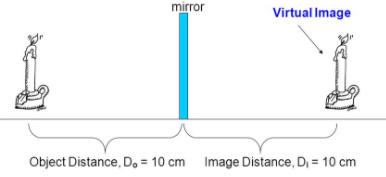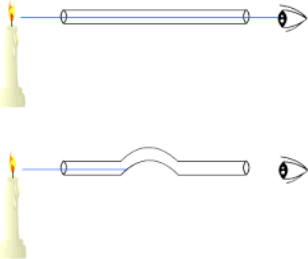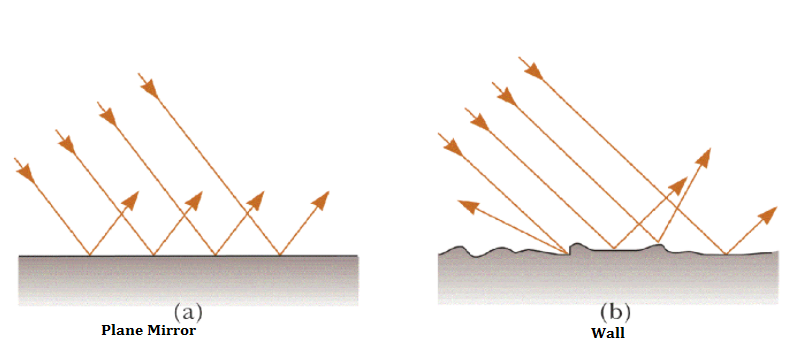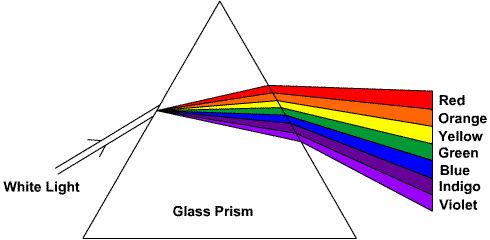7th Grade > Physics
LIGHT MCQs
:
Properties: 1 Mark each
Light has the following characteristics:
i) It travels in straight line.
ii) It does not require any medium to travel.
iii) It exhibits phenomena of reflection, refraction and scattering.
:
Concept: 1 Mark
Result: 1 Mark
A plane mirror always creates an object at an equal distance of how far the object is from the mirror.
If the distance between the object and image formed from the plane mirror should be 20 m, then the object should be placed 10 m from the plane mirror.

:
Proof: 2 Marks
Result: 1 Mark
We can easily prove that light travels in a straight line because the moment we put some opaque object in front of our eyes, we are unable to see anything that would be reflecting light. If the light wasn't travelling in a straight line, some light should have had fallen into our eyes.

When the light gets obstructed by some object, a dark patch is formed directly behind it since light cannot pass through the object. The dark patch is called a shadow of the object.
:
Shiny Objects as Mirrors: 1.5 Marks
Walls as Mirrors: 1.5 Marks
In mirrors, when light falls on them, the reflected rays are still parallel since the shiny surfaces are very smooth and hence the reflected rays of light reach our eyes. Mirrors also reflect most of the light that falls on them. That's why we can see objects through the mirror or any shining surface.
Walls surface are rough. When light falls on rough surfaces, the reflection of light is much more dispersed and irregular. Rough surfaces like walls reflect only a part of the light that falls on them. Since all the reflected rays do not reach our eyes, we cannot see any image and due to this, walls do not act as mirrors.
:
How we see anything: 2 Marks
Luminous objects: 1 Mark
Sometimes light from the Sun can be seen passing through clouds and the rays appear to be straight lines. After light is reflected off of an object, such as a tree or a book, it still travels in straight lines, but in a different direction because of reflection. If the light enters our eyes, we see the object (i.e. our eyes can detect light). For example, if light from the Sun strikes an object, the light is usually reflected off of that object. We can see things because of the light that is reflected off of them. If light is not reflected into our eyes, we do not see them.![Click to Enlarge Image Do We See All Objects Due To Reflected Light? [3 MARKS]](https://lakshyaeducation.in/quizpics/quiz/content_howdoweseethings.jpg)
There are objects which give their own light such as sun, fire, bulb etc. That's why we see them. These objects are known as luminous objects.
:
Converging property with diagram: 1.5 Marks
Diverging property with diagram: 1.5 Marks
If parallel rays of light fall on a convex lens they converge when passing through and meet at a point on the other side. That's why the convex lens is known as a converging lens.
If parallel rays of light fall on a concave lens they diverge as they pass through the lens never to meet at a point. That's why we call them diverging lens.
:
Concave lens: 1 Mark
Convex lens: 1 Mark
Use: 1 Mark
Convex lens: A converging lens can produce both virtual and real image. It depends on the position of the object placed in front of the lens.
Concave lens: A diverging lens can only produce a virtual image. After refraction from the lens, the rays of light never meet.
Use of convex lens: A refracting telescope uses two convex lenses.
Use of concave lens: Most high-quality cameras, telescopes and binoculars use concave lenses to improve the quality of the images they provide.
:
When: 1 Mark
Why: 2 Marks
Rainbows happen when sunlight and rain combine in a very specific way. Indeed, rainbows often indicate that the rain has passed. Generally, it will be sunny when you see a rainbow, but rain clouds (usually cumulonimbus ) will be just a short distance away. In order to see a rainbow, you'll need two ingredients: sunlight and raindrops.
Just after rainfall, the air in the atmosphere is fairly moist with water droplets still clinging on to some dust particles. When light falls on these water droplets and vapours, it gets dispersed into its constituent seven colours. These seven colours are in the shape of an arc and are known as a Rainbow.
![Click to Enlarge Image When And Why Is A Rainbow Formed? [3 MARKS]](https://lakshyaeducation.in/quizpics/quiz/content_rainbow.png)
:
Difference :3 Marks
Forming Images : 2 Marks
(i) Real images are those images which are formed on the screen or those images which can be obtained on the screen.
(i) Virtual images are those images which cannot be obtained on the screen.
(ii) Real images are formed when light rays actually meet at a point.
(ii) In the formation of a virtual image, light rays do not actually meet but appears to meet.
(iii) A real image is always inverted.
(iii) Virtual image is always erect.
Real images can be formed by a Concave mirror or Convex lens, by placing a screen behind the respective mirror or lens.
On the other hand, a virtual image can be produced by a concave lens or Convex mirror.

















